A few lucky souls have stumbled on diamonds in glacial debris around the Great Lakes and further north into Canada for centuries. Geologists have known that the sources of those diamonds represented a vast wealth of hidden treasure somewhere in the frozen tundra of northern Canada, but it was not until the late 1980s that a couple of cowboy geologists, Chuck Fipke and Stewart Blusson, painstakingly ferreted their way back to the source. But I am getting way ahead of the story.
Diamonds are brought to the surface from deep within the upper mantle via unusual igneous rocks called kimberlites (and sometimes lamproites). I recognize I run the risk of losing my readers by delving into the nature of kimberlites, but to a geologist like myself kimberlites are crazy types of rocks. Typical magmas (and lavas) like basalt form by partial melting of the mantle. Kimberlites, on the other hand, are geologically unique because although they form from partial melting of the mantle, the melting is significant enough for these rocks to resemble compositionally (not precisely) the mantle itself. They are referred to as ultramafic rocks as compared with basalts which are mafic (mafic means rich in magnesium and iron – two of the most abundant elements in the mantle).
Diamonds actually don’t form in kimberlites. Think of kimberlites as a conveyor belt bringing diamonds that form under high temperatures and pressures (from about 125 to 175 kilometers1) to the surface relatively fast, before they can reequilibrate (breakdown) into other compounds like graphite or carbon dioxide. Diamonds are not forever. Many an exploration program has had its hopes dashed with the discovery of kimberlite full of octahedral or other cubic forms of graphite — degraded diamonds2.
Exploration for diamonds can be excruciatingly frustrating. There are 6,400 known kimberlite pipes worldwide but only 30 or so have become viable mines — that’s about 0.5% chance that a discovered kimberlite will turn into a producing mine. It’s true, diamondniferous kimberlites are hard to find, but you don’t need many diamonds to make a mine. High-grade diamond kimberlites only contain a few carats per ton of rock. That’s enough to make any geologist rich beyond her dreams. Kimberlites form at greater than 200 kilometer depths (200 to 600 km) and are enriched in volatiles (e.g., carbon dioxide and water) that make the magmas not only buoyant but explosive. They literally “blow” through the upper mantle and crust in perhaps a matter of hours (rates postulated are about 14 km/hr) forming carrot-shaped pipes called diatremes (see the diagram below). The faster the better for diamond preservation. But they also have to pick diamonds up along the way or incorporate them as the magma forms. Kimberlites can contain as much as 25 to 50 percent rock within their magma acting as an elevator to the surface for mantle material helping geologists understand the mantle3.
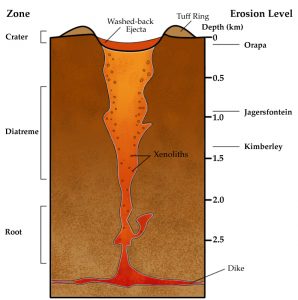 Asbestos Wikipedia
Asbestos Wikipedia
After half a century or more of serious diamond exploration. we have learned that diamond-bearing kimberlites form below the cratons. The cratons are the ancient regions of continents containing rocks greater than 2 billion years old. There is still great debate about how the cratons formed, but every continent is rooted in these ancient environs. If you are looking for diamonds, go to the cratons. Before the 1980s, diamond kimberlite mines had been developed on every craton of all the continents except Antarctica and North America. Diamonds come from two major sources: mantle rock (e.g., peridotite) and eclogite (metamorphosed basalt). Diamond formation in peridotites occurred primarily in the Archean centered on a time about 3 to 3.3 billion years ago but some dates are as young as 1.9 billion years ago. Eclogite diamonds tend to be younger from 1 to 2.9 billion years ago.
Where does the carbon come from to form diamonds? No one knows for sure, but most researchers think that the carbon along with sediments and volatiles were subducted through plate tectonics (the ecologites brought up by kimberlites are likely ancient subducted ocean floor)4. I am interested, through my own research, on how the cratons formed and when subduction began. Many geologists pooh-pooh the idea that subduction could have begun so early in earth history so it is satisfying to see how diamond research supports the early existence of plate tectonics and subduction. My colleagues and I have contended for years that the cratons are the result of ancient subduction.
Imagine Chuck Fipke in the 1980s looking out over the vast expanses of northern Canada contemplating all the diamonds he believed had to be out there in the craton hidden below tons of glacial deposits. Those damnable glacial deposits were the reason no one had discovered pipes in Canada5. The map below shows the furthest extent of the glaciers 17,000 years ago and the site of the diamond pipes eventually discovered. Fipke also had to contend with De Beers, the giant cartel that controlled the world’s diamond markets. They were actively exploring with their practically unlimited resources. I worked for De Beers as a consulting geologist for a time in the mid 1990s in Russia, and I can assure you, they are a force to be reckoned with.
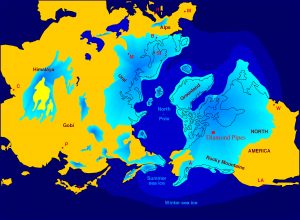 Base map from Wikipeida
Base map from Wikipeida
By the mid 1980s, geologists had discovered that the mantle material brought up by kimberlites could aid them in their exploration thanks to a geochemist named John J. Gurney at the University of Capetown. Diamonds form in equilibrium at specific temperatures and pressures with other minerals more abundant than diamonds. Gurney, funded by Superior Oil, analyzed extensive mineral assemblages from kimberlites with and without diamonds and found that there are chemical signatures in the minerals that show up when diamonds are present. One of the more famous diagrams is that of the chromium and calcium concentrations in garnets from the mineral assemblages. Garnets fall into two groups on the diagram called G10 and G9 and virtually all garnets that occur with diamonds fall within the G10 field shown below. As mentioned before, diamonds can reequilibrate in kimberlites and become graphite or evaporate away as carbon dioxide. The diagram shows the line of stability under chromium saturation where diamonds will breakdown. Some diamonds remain stable in the graphite field because the conditions do not last long enough to degrade the diamonds. But if G10 garnets fall above the diamond-graphite equilibrium line it is a pretty sure bet you are on the right track for diamondiferous kimberlites. And that is precisely what Fipke kept finding in in his samples of glacial debris as he flew along with Blusson (who not only has a PhD but is a pilot) periodically sampling them. The long-gone glaciers were pointing the way.
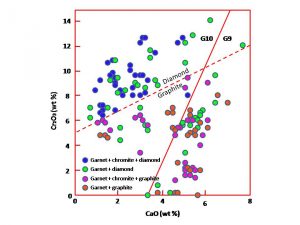 After Nowicki et al., 2007
After Nowicki et al., 2007
At the time in the mid 1980s, geologist understood the relationships between these indicator minerals and diamonds, but how could the information be used to find the kimberlites in the Canadian craton? What was unique about Fipke and his partner Blusson was the way they approached the problem. They knew that the glaciers were powerful enough to gouge out the relatively soft kimberlite and carry the indicator minerals long distances destroying any signs of the kimberlites at the surface and subsequently burying them under debris carried by the glaciers when they melted. They reasoned that they might be able to sample glacial deposits and “walk” the indicator minerals back to their source. Standard Oil liked the idea and funded their exploration at first. No one knew then that it would take eight years, millions of exploration dollars, and several companies before they hit pay dirt. De Beer’s geologists also knew the answer was in the glacial remains, but to them it was a nine to five job and the season ended after 8 weeks of summer collecting. For Fipke, it was a life’s dream, and nothing terminated his resolve collecting well into the cold months of the far north.
Fipke and Blusson focused on eskers (see the esker shown below) which are sinuous ridges of stratified sand and gravel deposited by water flowing in tunnels of ice within or under the glaciers. As the glaciers recede the ridges remain like compasses indicative of the direction the water and ice once flowed. If the glaciers rumbled over kimberlites, the proof would be in the streams that carried the glacial till away. They kept going even after Standard Oil called it quits. The G10 garnets kept telling them they were on the right road and the mining giant BHP believed them when they began running out of money. Dia Met, the company Fipke and Blusson formed, signed a sweet deal with BHP. BHP agreed to fund the exploration for a 51% stake. Within six months after teaming with BHP, Fipke had come to a point where the G10 garnets disappeared near Lac de Gras. Fipke knew he was close to the source. As the story goes, he noticed a lake from the air that looked like it sat in a bowl-shaped depression near where the G10 garnets disappeared. He had to have a sample of the rock in that depression. They landed the plane on the lake, rowed to shore, and started to dig, but after many hours they were still in glacial till. They decided to walk the shoreline for a better place to dig. That is when Fipke’s son Mark, found a piece of kimberlite. They were all ecstatic — the lake must sit on the pipe. Gurney eventually analyzed the mineral assemblage and verified that it was highly likely to be a diamond-bearing kimberlite. BHP quickly flew a geophysical survey which showed a distinct structure below the lake.
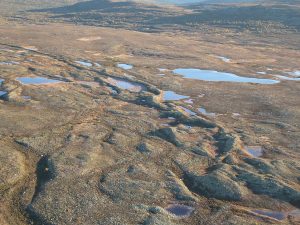 Esker in Sweden (Hanna Lokrantz Wikipedia)
Esker in Sweden (Hanna Lokrantz Wikipedia)
BHP and Dia Met started quietly staking as much land around the lake as they could. Kimberlite pipes frequently occur in bundles so it was imperative that they obtain rights to as large a region as possible before word got out of the find. While they were staking, BHP flew a drill rig in by helicopter and cored 455 feet under the lake pulling out beautiful samples of kimberlite 33 feet below the glacial debris with 80 plus small diamonds. Canadian law requires that companies announce to their shareholders when a potentially profitable body is found. On November 12, 1991 they announced the results from the core including the fact that a few gem-quality diamonds had been recovered from the core. All hell broke loose, and the rush was on by large and small companies alike to stake as close to BHP’s claims as possible in the hopes that other pipes might be buried nearby. BHP would go on to discover more than 150 kimberlite pipes helping to make Canada the third largest producer of diamonds in the world. De Beers even found a few mines. Fipke and Blusson became billionaires overnight (if you don’t count the 8 years of exploration).
The image below shows the Etaki mine – one of the producing mines staked within Fipke’s original claims. The large circular depressions in kmberlite represent part of the open-pit mining operations BHP is running.
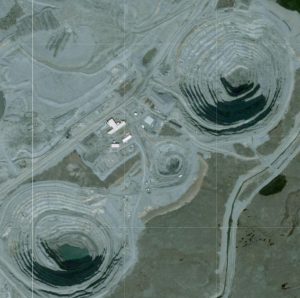 Ekati mines from the air (Google Maps)
Ekati mines from the air (Google Maps)
- Shirey, S. B. and Richardson, S. H. (2011) Start of the Wilson Cycle at 3 Ga shown by diamonds from subcontinental mantle: Science 333, 434-436 ↩
- Pearson, D. G., Davies, G. R., Nixon, P. H., and Milledge, H. (1989) Graphitized diamonds from a peridotite massif in Morocco and implications for anomalous diamond occurrences: Nature, 338, 60-62 ↩
- Russell, J. K., Porritt, L. A., and Hilchie, L. (2013) Kimberlite: rapid ascent of lithospherically modified carbonatitic melts: In Pearson, D. G. et al, Proceedings of 10th International Kimberlite Conference Vol. 1 p. 195-210 ↩
- Nowicki, T. E., et al. (2007) Diamonds and associated heavy minerals in kimberlite: A review of key concepts and applications: Developments in Sedimentology, 58, 1235-1267 ↩
- Cross, L. D. (2011) Treasure Under the Tundra: Canada’s Arctic Diamonds: Heritage House Publishing Co ↩
